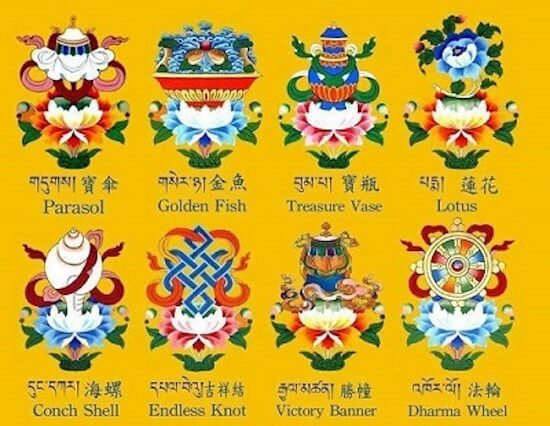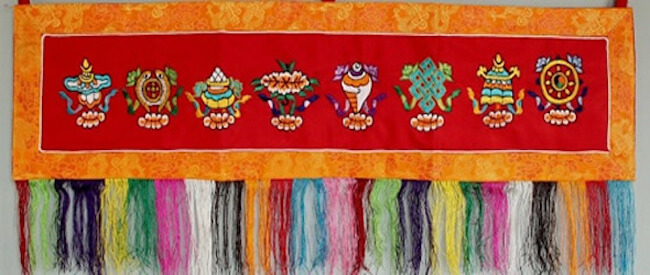 Tashi Tagye or Ashtamangalaas, known in Sanskrit (ashta means eight and mangala means auspicious), refers to the eight signs of auspiciousness which are popular in Indian religions, including Buddhism. They are associated with different parts of the Buddha’s body and are also shown as hand implements of the eight offering goddesses. They also symbolize auspicious topics and enlightened qualities. The signs are commonly carved, printed or painted on different surfaces in Bhutan like dzongs, temples, monasteries, homes and offices.
Tashi Tagye or Ashtamangalaas, known in Sanskrit (ashta means eight and mangala means auspicious), refers to the eight signs of auspiciousness which are popular in Indian religions, including Buddhism. They are associated with different parts of the Buddha’s body and are also shown as hand implements of the eight offering goddesses. They also symbolize auspicious topics and enlightened qualities. The signs are commonly carved, printed or painted on different surfaces in Bhutan like dzongs, temples, monasteries, homes and offices.
Jewelled Parasol
The parasol decorated with precious jewels represents the Buddha’s unfathomable head. It also signifies the many umbrellas, parasols and canopies offered to the Buddha by the celestial and human kings, and the Buddha blessed it as a symbol of protection from the heat of suffering. The parasol with its silken cloth, golden shaft and jewel ornaments represents the various aspects of the Buddha’s teachings, which give peaceful solace and protection from suffering.
Auspicious Golden Fish
The golden fishes represent the Buddha’s compassionate and clairvoyant eyes and the agility and swiftness of the Buddha’s enlightened spirit. The two fish symbolize the two types of penetrating and transcendental wisdom of the Buddha. They are also said to symbolize the two great rivers Ganga and Yamuna, solar and lunar powers, fertility and abundance, wisdom and compassion.
Wish-fulfilling Vase
The wish-granting vase represents the Buddha’s throat, which is considered an inexhaustible treasury of vast and profound teachings. It also symbolizes the wealth of spiritual qualities, a container of nectar for immortality, and in the worldly sense, a receptacle filled with the essence of various riches.
Beautiful Lotus
The lotus flower represents the tongue of the Buddha, which is free from flaws of speech, is endowed with eloquence and other good qualities and relishes the profound taste of the dharma. Just as the lotus is not sullied by its muddy environment but thrives in it, the Buddha thrives in the world, unaffected by it. Thus, it symbolizes purity and immaculate existence.
Conch
The conch shell, which spirals clockwise, represents the deep, melodious and pervasive voice of the Buddha and the sound of dharma, which awakens sentient beings from the slumber of ignorance. The conch shell was offered to the Buddha by Indra to request him to 'turn the wheel of dharma' or teach and was hence blessed by the Buddha as an auspicious sign. It symbolizes fearlessness and resounding victory.
 Eternal Knot
Eternal Knot
The endless knot represents the profound and mystical nature of the Buddha’s heart or mind. Its intertwining structure symbolizes the interdependence and interpenetration of reality and the complex and intricate nature of all phenomena. The eternal and endless design indicates the immutable and adamantine state of enlightenment and the ultimate nature of things.
Victory Banner
The banner of victory represents the Buddha’s body and his victory over the four kinds of evil forces and the other eight lucky signs of the Bhutan opponents. Originally based on the use of banners in warfare, the victory banner in the Buddhist context symbolizes the victory of positive, virtuous forces over negative ones and the invincibility of an enlightened being.
The Wheel of Dharma
The wheel of dharma represents the Buddha’s feet, on which is clearly embossed the pattern of a wheel, one of thirty-two marks of an enlightened person. Besides, Brahma is said to have offered a thousand-spoked wheel to the Buddha in order to ask him to teach or turn the wheel of dharma. The Buddha blessed the wheel as an auspicious symbol and used the wheel as a metaphor for his spiritual teachings. Just as a Universal Monarch is said to possess a wheel that would lead his military forces and subjugate the opponents, the Buddha used his teachings to lead his disciples and subdue the negative forces.